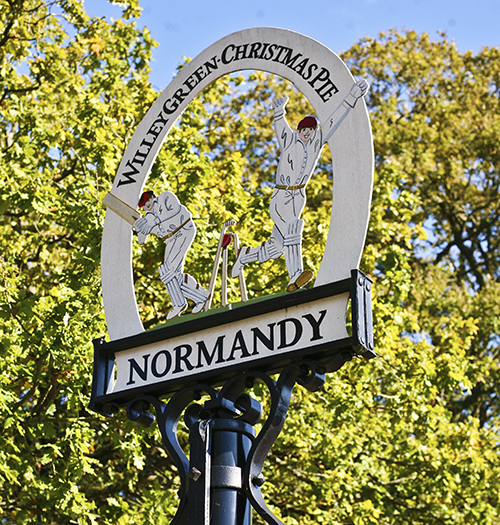At the Taylor Wimpey (TW) 'consultation event' on 18 July, many people were either confused or angered by TW’s claim that “The land is grey belt, previously developed or underused and not strongly contributing to the Green Belt’s wider purposes”. In this note we show why that was a disingenuous statement, and clarify what is meant by ‘Grey Belt’.
The key point is that ‘Grey Belt’ is a purely administrative term that allows certain Green Belt land to be considered for development, although it is not a guarantee that approval will be given. It is not a judgment on the aesthetic or other qualities of the land in question. It is merely a first step in a complex sequential process for deciding on planning applications.
‘Grey Belt’ as a concept was trailed by the Labour Party in opposition. It was usually illustrated by reference to ‘a disused petrol station in North London’ that happened to sit in the Green Belt and was clearly a suitable site for development. The initial consultation in 2024 on proposed changes to the National Planning Policy Framework (NPPF) reflected this idea: Grey Belt was defined as “Previously Developed Land and any other parcels and/or areas of Green Belt land that make a limited contribution to the five Green Belt purposes.”
The five purposes of the Green Belt are:
a) to check the unrestricted sprawl of large built-up areas;
b) to prevent neighbouring towns merging into one another;
c) to assist in safeguarding the countryside from encroachment;
d) to preserve the setting and special character of historic towns; and
e) to assist in urban regeneration, by encouraging the recycling of derelict and other urban land.
However, when the final version of the NPPF appeared, the definition of Grey Belt had changed to: “land in the Green Belt comprising previously developed land and/or any other land that, in either case, does not strongly contribute to any of purposes (a), (b), or (d)”. In other words, unless a site checked the sprawl of a large built-up area, prevented neighbouring towns from merging with each other, or preserved the setting and character of historic towns, it could be considered as ‘Grey Belt’. Assisting in safeguarding the countryside from encroachment no longer counted. In reality this meant that most areas in the Green Belt could potentially be considered as Grey Belt.
(NB, subsequent, more detailed, Green Belt guidance makes clear that preventing neighbouring villages merging with each other doesn’t count, either.)
The Government would no doubt argue that its intent was to make it easier for sites to be considered for development, even if they were in the Green Belt. Note that ‘Grey Belt’ is still in the Green Belt. This removes the requirement for “exceptional circumstances” to be demonstrated where Green Belt boundaries are altered, usually as part of the Local Plan process.
‘Grey Belt’ is therefore a purely technical, administrative term, that allows a wider range of sites to be considered, without any presumption that they do not make an important contribution to the openness of the Green Belt. That aspect is indeed considered, but during the next part of the sequential process. As a government minister wrote when we queried this with them:
“However, identifying land as grey belt does not grant anyone planning permission; nor does it set aside the need to have regard to all relevant protections in policy and law which are designed to limit impacts on the natural environment. The potential consequences of any planning proposal have to still be assessed on the facts and circumstances, in the light of all relevant Plan policies and policy in the Framework.” (Letter from Parliamentary Under-Secretary of State for Housing and Local Government of 30 June 2025.)
TW’s assertion that the Normandy/Flexford site is “previously developed or underused and not strongly contributing to the Green Belt’s wider purposes” is therefore misleading. The site is clearly not previously developed, nor underused, and whether or not any site contributes to the Green Belt’s wider purposes is something that is assessed at the later stage in considering any application, and is not excluded by its being ‘Grey Belt’.
[Addition: 10 August. We should have added that not every site that could potentially be 'Grey Belt' under the criteria listed above will be judged to be so. Footnote 7 to the NPPF lists a number of grounds for excluding sites from consideration, including those where protected habitats might be endangered, or where there is an existing risk of flooding. The force of these exclusions can be seen in the decision of a Planning Inspector to refuse an appeal against a decision of Guildford Borough Council not to grant planning permission for application 24/P/01167: The construction of a care home, with 17 one bedroom bungalows with staff accommodation and 10, one and two bedroom affordable homes on a site opposite St Mark’s Church, Wyke.
The Inspector concluded that: “the proposal’s adverse effect on the SPA [Thames Basin Heaths Special Protection Area, i.e.The Ash Ranges] as well as its impact on flooding and the Green Belt, provide a strong reason for refusing the development proposed. As a result, the presumption in favour of sustainable development does not apply and for the same reason the appeal site is excluded from Grey Belt”]
This is inevitably a short summary of a complex set of issues. If anyone has a specific question about anything we have covered, please email us at This email address is being protected from spambots. You need JavaScript enabled to view it.


